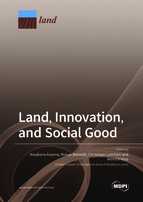Land, Innovation, and Social Good
A special issue of Land (ISSN 2073-445X).
Deadline for manuscript submissions: closed (31 January 2021) | Viewed by 67644
Special Issue Editors
Interests: property valuation; participatory geo-information science; land use planning
Special Issues, Collections and Topics in MDPI journals
Interests: ICT4D; land informatics; digital business
Special Issues, Collections and Topics in MDPI journals
Interests: land administration; cadastre; land information systems and modelling; pro-poor land recordation
Special Issues, Collections and Topics in MDPI journals
Interests: land use planning; land management; land valuation
Special Issues, Collections and Topics in MDPI journals
Special Issue Information
Dear Colleagues,
The administration of land tenure, value, and use is undergoing a new wave of technological innovation. The maturation and scaled implementation of crowdsourced data capture techniques, imagery-based mapping approaches, and cloud storage options are all adding to the expanded land administration toolbox. Meanwhile, a mix of even more novel developments is under development, including adoption of big data capture feeding into artificial intelligence applications, including automatic parcel boundary extraction, automated valuation models, mass valuation, and computer-assisted land use planning decision support systems for smart cities. Countering these positive developments in the land administration domain are ongoing challenges relating to land rights inequality, slum formation, food insecurity, and exposure to disasters, amongst others. The challenge remains to better harness technological advancement to better support fair and responsible relationships between people and land.
This Special Issue focuses on how innovative approaches to land tenure, land value, and land use planning can directly contribute, both positively and negatively, to these societal issues at local, national, and global levels.
We invite papers that link innovative technologies in the areas of land tenure administration, land value modeling, and land use planning to specific societal problems such as climate change, land tenure insecurity, gender access to land, rapid urbanization, food security, and poverty reduction.
Dr. Kwabena Asiam
Dr. Rohan Bennett
Prof. Dr. Chrit Lemmen
Prof. Dr. Winrich Voss
Guest Editors
Manuscript Submission Information
Manuscripts should be submitted online at www.mdpi.com by registering and logging in to this website. Once you are registered, click here to go to the submission form. Manuscripts can be submitted until the deadline. All submissions that pass pre-check are peer-reviewed. Accepted papers will be published continuously in the journal (as soon as accepted) and will be listed together on the special issue website. Research articles, review articles as well as short communications are invited. For planned papers, a title and short abstract (about 100 words) can be sent to the Editorial Office for announcement on this website.
Submitted manuscripts should not have been published previously, nor be under consideration for publication elsewhere (except conference proceedings papers). All manuscripts are thoroughly refereed through a single-blind peer-review process. A guide for authors and other relevant information for submission of manuscripts is available on the Instructions for Authors page. Land is an international peer-reviewed open access monthly journal published by MDPI.
Please visit the Instructions for Authors page before submitting a manuscript. The Article Processing Charge (APC) for publication in this open access journal is 2600 CHF (Swiss Francs). Submitted papers should be well formatted and use good English. Authors may use MDPI's English editing service prior to publication or during author revisions.
Keywords
- land tenure
- land value modeling
- land use planning
- artificial intelligence
- decision support systems
Related Special Issue
- Land, Innovation and Social Good 2.0 in Land (8 articles)









